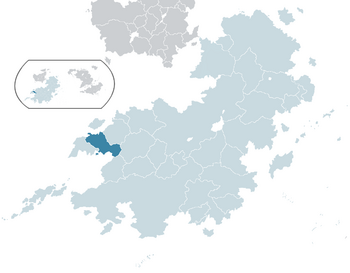Arthasthan
This article is incomplete because it is pending further input from participants, or it is a work-in-progress by one author. Please comment on this article's talk page to share your input, comments and questions. Note: To contribute to this article, you may need to seek help from the author(s) of this page. |
Socialist Republic of Arthadesh अर्थदेश समाजवादी गणराज्य Árthadeś Samājvādī Gaṇrājya | |
|---|---|
| Motto: यतो धर्मस्ततो जयः "Yato Dharmas-Tato Jayaḥ" "Whence Dharma, thence victory" | |
 Location of Arthadesh in Coius. | |
| Capital and largest city | Nadipatnam |
| Official languages | Samundrese |
| Recognised national languages | Utcalan Prasumi |
| Ethnic groups (2019) | Samundrese (35.3%) Utcalan (21.7%) Prasumi (19.3%) Vanavasi (13.8%) Tamisari (6.5%) Other (3.4%) |
| Demonym(s) | Arthai |
| Government | Federal parliamentary constitutional republic |
| Abhijit Kamalanayan | |
• Premier | Jaidayal Indushekhar |
| Legislature | Sansad |
| Independence from Etruria | |
| 1946 | |
| 1967 | |
| Area | |
• Total | 625,945.6 km2 (241,678.9 sq mi) |
• Water (%) | 4.5 |
| Population | |
• 2020 estimate | 107,281,772 |
• Density | 171.39/km2 (443.9/sq mi) |
| GDP (nominal) | 2020 estimate |
• Total | $816 billion |
• Per capita | $7,607 |
| Gini (2020) | 31.237 medium |
| HDI (2020) | 0.620 medium |
| Currency | Masha |
| Driving side | right |
Arthadesh (Samundrese: अर्थदेश Árthadeś), officially known as the Socialist Republic of Arthadesh (Samundrese: अर्थदेश समाजवादी गणराज्य Árthadeś Samājvādī Gaṇrājya), is a sovereign state in Satria, bordered by Padaratha to the west, Rajyaghar to the east, Ajahadya to the southeast, and Baekjeong to the south. It has a population of nearly 110 million, divided into 15 districts.
The area which makes up Arthadesh has been continuously inhabited for thousands of years, with archaeological remains recording the presence of sedentary agriculture from around 4,300 BCE and the existence of pastoralist groups before this time. Located at the delta of the Bashurat river, Arthadesh was a heartland for the development of the Sataro-Euclean peoples who arrived from the east and subjugated the endemic peoples. The fertile valleys of the Bashurat river helped grow several large states in the antique era, making Arthadesh a centre of religious and philosophical as well as economic exchange. This led to the birth of the Ashrama, philosophical and theological schools which centred upon religious asceticism and pacifism. Under the Ashramic period, which began around 700 BCE and which would continue until the emergence of the Sangma as a rival power, Arthadesh was the home of several wealthy states. However, at the coming of the common era, the Ashramic princedoms were subjugated by the Sangma dynasty. Arthadesh would remain under the Sangma for the majority of the dynasty's history, before the Nadipatnam Thakurate broke away and fought several wars with the central state. As Sangma power receded, more Arthadeshan Thakurates would break away, eventually forming a confederacy of princely states called the Arthadesh Confederacy. The confederacy was partially conquered by the Togoti Khaganate; its eastern region was directly annexed and its southern region was vassalized. Following the collapse of the Togoti Khaganate, a major general named Akdoğan, established his own fiefdom which became the Akdoğan Khanate. The Khanate faced strong competition from the Rajadom of Ajahadya. Desiring support, Arthadesh turned to Euclea and especially Etruria and Narozalica. While this was at first manifested by increased trade and military advisors, the Euclean powers began to extract concessions. Kassar, modern day Nagapur, was granted to Narozalica following a limited armed campaign, and in 1863 the Sardar was forced by Etruria to cede his state to Etrurian rule.
During the Great War, Arthadesh supplied troops to Etruria but was also a centre of activity for anti-Euclean resistance. After almost a century of Etrurian colonization and repression, anti-colonialist movements were largely destroyed, but the remaining nationalists and anti-colonialists were ardent socialists with the aim of establishing a socialist state. Independence would come during the Solarian War, led by the National Liberation Army, a branch of the Green Pardals. Following independence it established itself as a confederation of many Pardal Republics and other factions. Arthadesh was caught up in the chaos of the First Satrian War, and in the following decades Arthadesh fought several wars against Ajahadya which sought to unite the Satrian subcontinent under its rule. At the same time Arthadesh fought to spread socialism through Satria, before turning its attention solely to Ajahadya after its defeat in the Second Satrian War. A decade later, it was a member of the anti-Ajahadya coalition during the Third Satrian Warthat led to Ajahadya’s defeat. As a result of near constant warfare for several decades, the NLA became a fundamental part of Arthadesh. In the 1980s, the Socialist Republic was formally established. However the NLA maintained a significant role in Arthali society.
Arthadesh is classified as a flawed democracy and as a Southern democracy due to the influence of the National Liberation Army since independence. Ethnic and religious divides are also present, due to the diverse nature of the state which unites many different groups and religions. Arthadesh is a developing nation, reliant on agricultural production, manufacturing, commercial fishing, and tourism for the nation’s economy. The country is considered a middle power in Kylaris due its population and geographic location. It is a full member of the BCO as well as COMDEV. Due to its status as a socialist country it has close ties with the Association for International Socialism. It is also a member nation of the Community of Nations and the International Trade Organization.

